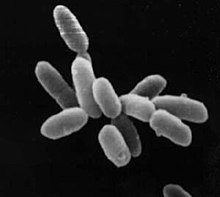Halophilic bacteria
| Haloarchaea | |
|---|---|
 |
|
| Halobacterium sp. strain NRC-1, each cell about 5 µm in length. | |
| Scientific classification | |
| Domain: | Archaea |
| Kingdom: | Euryarchaeota |
| Phylum: | Euryarchaeota |
| Class: |
Halobacteria Grant et al. 2002 |
| Order | |
| Synonyms | |
|
|
Halobacteria (also Halobacteriacea) are a class of the Euryarchaeota, found in water saturated or nearly saturated with salt. Halobacteria are now recognized as archaea, rather than bacteria. The name 'halobacteria' was assigned to this group of organisms before the existence of the domain Archaea was realized, and remains valid according to taxonomic rules. In a non-taxonomic context, halophilic archaea are referred to as haloarchaea to distinguish them from halophilic bacteria.
These microorganisms are members of the halophile community, in that they require high salt concentrations to grow. They are a distinct evolutionary branch of the Archaea, and are generally considered extremophiles, although not all members of this group can be regarded as such.
Haloarchaea can grow aerobically or anaerobically. Parts of the membranes of haloarchaea are purplish in color, and large blooms of haloarchaea appear reddish, from the pigment bacteriorhodopsin, related to the retinal pigment rhodopsin which it uses to transform light energy into chemical energy by a process unrelated to chlorophyll-based photosynthesis.
Haloarchaea have a potential to solubilize phosphorus. Phosphorus-solubilizing halophilic archaea may well play a role in P (phosphorus) nutrition to vegetation growing in hypersaline soils. Haloarchaea may also have application as inoculants for crops growing in hypersaline regions.
The extremely halophilic, aerobic members of Archaea are classified within the family Halobacteriaceae, order Halobacteriales in Class III. Halobacteria of the phylum Euryarchaeota (International Committee on Systematics of Prokaryotes, Subcommittee on the taxonomy of Halobacteriaceae). As of May 2016, the family Halobacteriaceae comprises 50 genera 213 species.
...
Wikipedia
